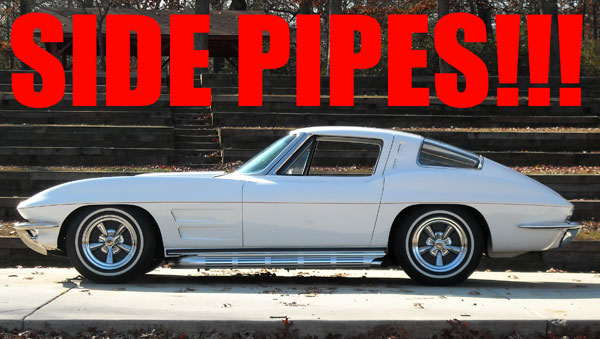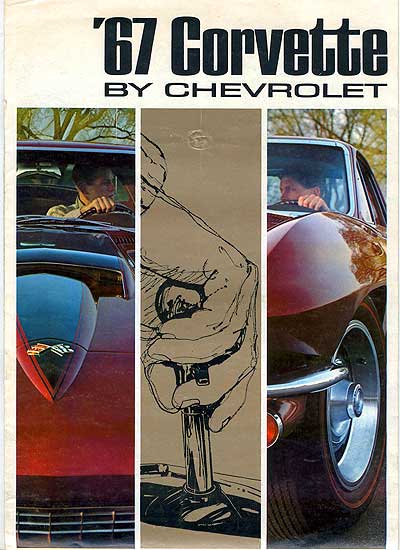A Look Back At An Inexpensive Option That Delivered a Little Extra Grunt and A Lot of BARK
Note: This article was first published in the December 2013 issue of Vette Vues. Subscribe to Vette Vues HERE! – Corvettes enjoyed a banner year in ‘08. When no one was looking, GM unleashed the latest variation of the LS generation small-block Chevrolet engine, the LS3. This latest edition of the highly successful LS series of GM engines is only 12-cubic-inches larger than the LS2, but uses the Z06-style valves and port design that features larger and straighter intake ports, nine-percent larger valves, and a five-percent higher cam lift. For what wasn’t much of a stretch, the LS3 netted out an extra 30-horsepower for the base model Corvette, which added up to a whopping 430-horsepower for the base Corvette! But a close look down the ‘08 Corvette option list shows a little item called, “Dual Mode Exhaust System” (RPO NPP) for $1,195. This was the first time since 1969 that Corvette buyers had a factory exhaust system option.
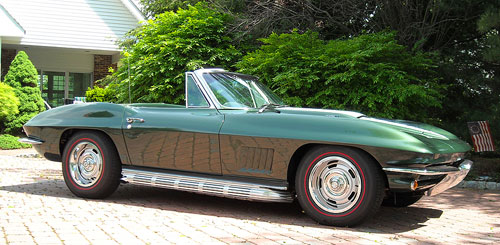
You could call it the Trickle-Down Horsepower Theory from the high-performance Z06. The Dual Mode option functions the same as the Z06 version. The outlet valves are vacuum-actuated to open during what Chevrolet calls, “high-load operation.” (That’s GM-speak for “get’n on it!”) While the Z06 version has 3-inch diameter exhaust pipes, the LS3 version uses 2-1/2-inch pipes. So, how much extra grunt do you get for your $1,195? The system adds 6-horsepower and 4-ft/lb of torque. While those numbers aren’t terribly impressive, the exhaust note certainly is. Of the 35,301 Corvettes sold in ‘08, 13,454 (38.1%) were equipped with the new system. That’s pretty cool, considering that’s only $199.16 per horsepower unit and $298.75 per torque unit, but we won’t quibble over numbers. After all, the system sounds great!
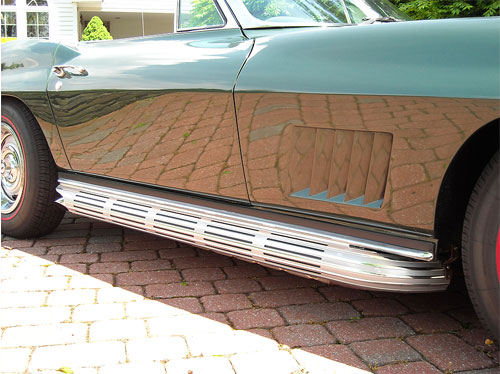
It all got me to thinking about those infamous, barking side-pipes that were offered from ‘65 to ‘67, and slightly milder ‘69 side-pipes that made even the 300-HP small-block sound as ominous as a junkyard dog. Two unique designs were offered back then. Beginning in ‘63, as part of the overall Z06 package, was the $37.70 N11 option, the Off-Road Exhaust System, which included low-restriction, under the car mufflers and 2-1/2-inch exhaust pipes. This option was available through to ‘68 and was officially listed as “off-road.” (That’s GM-speak for “race track”, is in, racing.) The N14 Side-mount Exhaust System was another animal altogether. The system begins at the end of the exhaust manifold flange with the typical 90-degree bend.
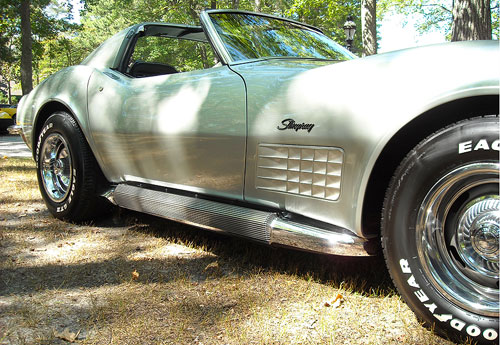
But instead of bending towards the back of the car, the bends were directed towards the sides of the car. After a short distance of about 12-inches or so, there was a gentle bend of approximately 118-degrees that leads to a long, straight tube that passed as a “muffler.” The “muffler” portion that ran along the side rocker panel had small crimps that created little internal baffles – and not much baffle at that.
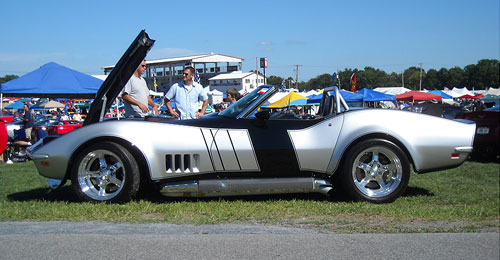
Since Chevrolet didn’t want to burn the ankles of their Corvette customers and passengers, a set of beautifully styled, aluminum covers were designed. Each cover featured five horizontal ribs, with five sets of vertical blacked-out indentations between the ribs. The standard side rocker panel was replaced with a narrow polished aluminum rib that was mounted over the top of the covers. These hid the attachment screws that held the side covers. At the end of the piece of long, chambered tube was a downward-pointing chrome exhaust tip. And here’s the kicker… the Side-Mounted Exhaust System cost was only $131.65 in 1965! Plus, the system looked fantastic! Talk about “muscle.” Side pipes not only made ‘65 to ‘67 Corvettes look serious, they sounded serious!
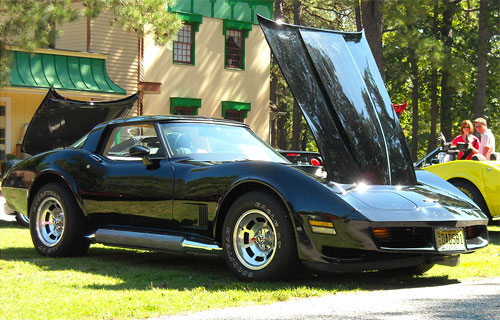
But as good-looking and inexpensive as they were, by the numbers, it wasn’t a terribly popular option. Only around 10-percent of all ‘65 to ‘67 Corvettes were optioned with the system. When the new Mako Shark II-inspired C3 Corvette came out in ‘68, the side-pipes weren’t on the options list. It was said that GM’s VP of Styling, Bill Mitchell, didn’t want to distract from the new shape with side-mounted exhausts. That may or may not be correct. It wasn’t that Mitchell was opposed to loud, side-mounted exhausts – nearly every concept and show car that came out of his studio had side-pipes as standard equipment. Considering what a nightmare it was getting the new Mako Shark II design out as a ‘68 model, perhaps there just wasn’t time for side-pipes.
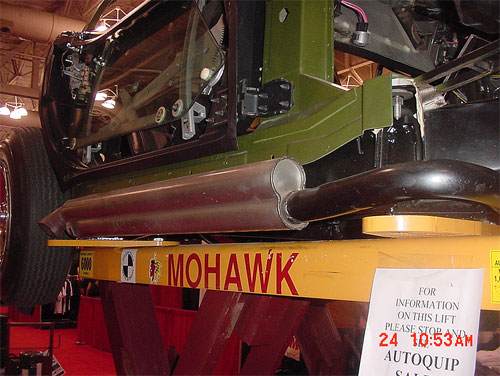
When the ‘69 Corvettes came out, side-pipe fans rejoiced over the return of the barking pipes. Only the new version didn’t bark as much. While the new pipes bolted on and functioned like their predecessors, the minimalist chambered pipe was replaced with a for-real muffler. However, the covers were beautifully styled to fit the unique shape of the Corvette’s side rocker panel.
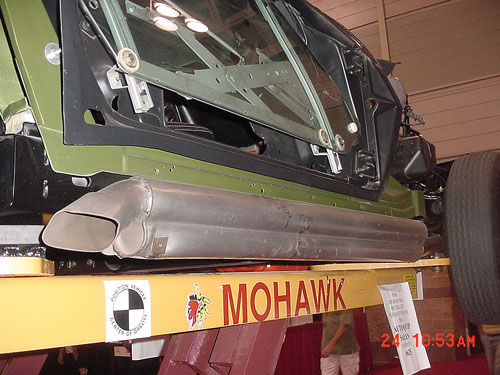
A few specialty performance builders, such as Joel Rosen of Baldwin-Motion fame, installed the ‘65 – ‘67 units on his ‘68 and a few ‘69 Phase III Corvettes. While they didn’t fit exactly right, they still looked great. Rosen also added the first generation side-pipes and covers to his Phase III Camaros, Novas, Chevelles, and Biscayne supercars, although due to the short Corvette wheelbase, the system was less aesthetically successful than the C3 Corvette application.
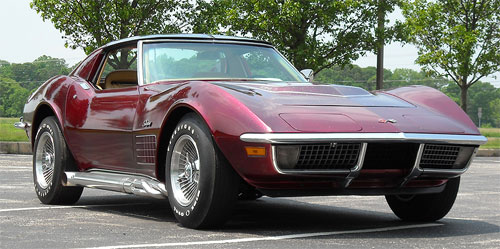
So aside from the barking exhaust note and added bragging rights, what did the side-pipe exhaust system do for the car’s performance? Unlike the C6 Dual Mode Exhaust system, the old side pipes were never promoted to increase horsepower at all, or at least, they were never officially tested and certified. Of course, the only way to really answer that question would be to rear-wheel horsepower test, say a 427/435 427 ‘67 Corvette with and without the side-mounted exhausts. A lot of work just to find some numbers.
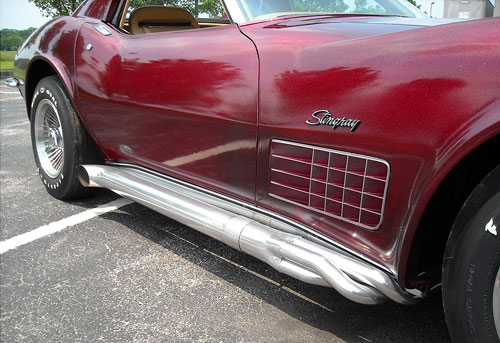
So, I took the question to two genuine experts – veteran Corvette racer, Dick Guldstrand and Mike Cederstrom, owner of Sweet Thunder Chambered Exhaust Systems, in Cadillac, Michigan. Since Guldstrand has spent thousands of hours building and racing Corvettes for over 50 years, I thought Goldie might know how much horsepower the side-pipes were worth. Dick’s answer was somewhat surprising. “Those old chambered pipes did improve the engine’s performance, but not much. But then again, almost anything you did was an improvement over the stock system. The ram horn manifolds were pretty good, but nothing like big tube headers with proper phasing and the scavenger effect. But they sure sounded good!”
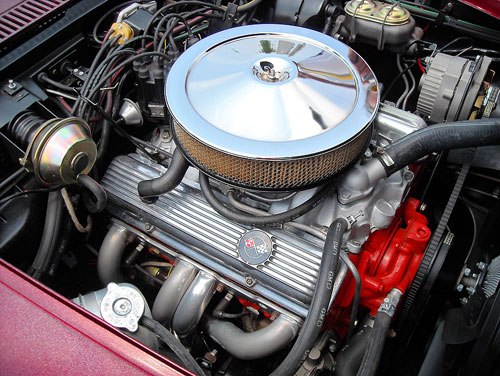
My conversation with Guldstrand was very historical. According to Mike, GM first started using the low-restriction chambered pipes as part of the ‘61 Oldsmobile Starfire performance package and standard equipment on the ‘64 – ‘65 models. But since the pipes were mounted under the cars and not on the sides, hardly anyone took notice. Meanwhile, over at Chevrolet, with the new big-block 396 engine coming out in ‘65 and the L84 Fuelies were making their last appearance, the Corvette designers wanted a little something extra and got approval to offer the chambered-pipe Off-Road Exhausts optional on all model Corvettes.
The chambered pipes have distinctive “crimps” on the exterior. Inside of each side-pipe is an inner 1-3/4” inner baffle tube with hundreds of small perforations. The crimps on the exterior are there to create the chambered sections, these are specific sizes that combined with the special perforations on the inner baffle tube. These two factors are what they used to help control different exhaust sounds. The “muffling” effect comes from all of those tiny perforations, which burn off after a few years of regular use. With only a 1-3/4” inner baffle tube, you can see why some call the side-pipes “chokers” and why Guldstrand commented that they helped a little, but not much.
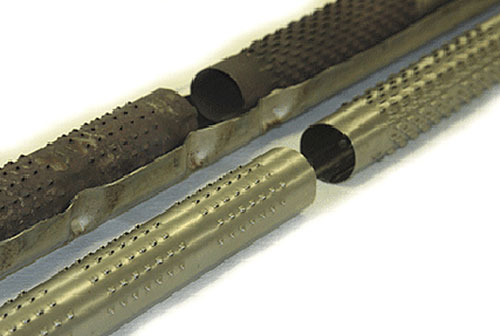
An educated guess might be close to what the new Dual Mode Exhaust System is worth – around 6-horsepower. Had the inner perforated tubes been in the neighborhood of 2-1/2-inches, horsepower increases would have been more substantial. “Why” the 1-3/4-inch inner tubes were chosen is anyone’s guess. Design engineers may have felt that was “enough.” Or perhaps larger diameter inner pipes were experimented with and were determined to be excessively loud. Within my extensive library of Corvette history books, I have never read of an accounting of side-pipe development. It is widely believed that mid-year Corvettes equipped with factory RPO N11 – the “Off-Road Exhaust System” consisting of a pair of GM “Hi-Flow” mufflers in the stock 2-1/2-inch exhaust system would out-perform side-pipes.
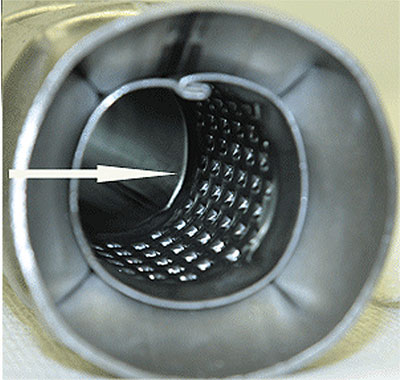
Of course, side-pipes of one kind or another had been showing up on racing, experimental, and show car Corvettes since earliest Fuelie racers in ‘57 and the stunning Corvette SS racer. Many of Bill Mitchell’s important show and concept cars wore their exhausts on the sides from the ‘59 XP-700 dream car to numerous modified production-based show cars, as well as his Mako Shark I and Manta Ray cars. The Mako Shark I had exposed header pipes protruding from the sides of the fenders that blended into a collector fitted to a decorative, finned muffled cover. While these setups looked dreamy as show cars, exposed header pipes on a production car would never happen. But they did help pave the way for the tamer but deliciously loud chambered side pipes. Until steel tube headers became common, most racing Corvettes used the stock ram horn cast-iron manifolds and would either have a 2-1/2-inch diameter open pipe that exited just in front of the rear wheel or ran along the side rocker. This setup was obviously considered “open” exhaust and was completely illegal for the street.
Not that the factory optional chambered exhaust didn’t create a few problems with young Corvette owners, such as myself. Several inspection officers at my local DMV threatened to not pass my ‘65 Coupe with factory side-pipes because they didn’t like loud cars. I always passed… barely. Once I was told that if I came back next year with THAT CAR, it would DEFINITELY not pass! It wasn’t until my conversation with Sweet Thunder Mike that I learned why my ‘65 Coupe was so loud. Mike asked, “Were those original pipes?” To the best of my knowledge, my car came from the factory that way. They certainly weren’t “header” side-pipes. When I owned the car, it was 10 years old. Mike said, “That’s why. Those little perforations that were stamped into the very thin aluminized steel, didn’t last that long. The whole inner tube would just rot away. You were running nearly straight open exhausts!” he laughed.
I shared with Mike that my girlfriend at the time once said to me, “Your car is really cool, but it’s deafening!” Of course, it didn’t keep her from wanting to drive it from time to time. Once I thundered by a fellow in a 356 Porsche. As we were approaching a traffic light, I could see that he was quite agitated and was yelling at me, “I only got FOUR CYLINDERS, MAN! Four cylinders!!!” I thought, “Well, don’t complain to me!” So I pushed the clutch in and barked the side-pipes for good measure. Another time I passed a coworker friend on the way to work in a, shall we say, ‘spirited fashion” at around 6,000 rpm in second gear. Later in the office, my friend came over to my drawing board and said, “That car of yours is SO FRICK’N LOUD, I could feel the side windows in my Camaro rattling!”
Chambered exhaust systems eventually found their way into Camaro, Chevelle, and dealer-installed AMX cars. Usually, these systems ran under the cars to not draw too much attention. Former VETTE editor and founder Marty Schorr had a tricked out, black 390 Javelin with a set of ‘65-’67 Corvette side-pipes and covers. And what can only be considered a true anomaly was that a small handful of new Corvette buyers opted to have their new Corvettes equipped with dealer-installed Hooker Header side-pipes.
While repro side-pipes have been available for some time now, the guys at Sweet Thunder have invested a lot of time and energy into the reproduction of these new side-pipes with the correct sound. For more information and photos, visit Sweet-Thunder.com. Mike and his team also make chambered exhaust systems for the new 2010 Berger Chevrolet Super Camaros, as well as chambered exhaust systems for several other cars.
So, will side pipes ever come back as a production option for Corvettes? The short answer is, “No!” And many would ask, “Why would anyone want them?” After all, strictly “by the numbers” when offered, side-pipe-equipped Corvettes only accounted for 10-to-11-percent of new Corvettes. However, the side-pipe systems were available for many years through your local Chevrolet Parts Department, to be self-installed by owners. For several decades, ‘75 and newer C3 Corvettes that were equipped with catalytic converters could not have side-pipes and pass inspection. However, now that all of the C3 Corvettes are well over 25 years old and are considered “historic” cars, there’s a lot more leeway.
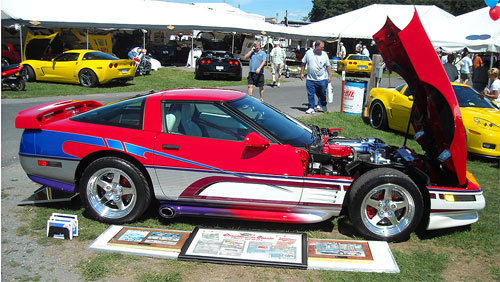
And what about C4 Corvettes you ask? The folks from Power Effects® obviously have a passion for side-pipes. What’s surprising about their Side Effects® system is that it’s actually a Cat-Back design. The factory catalytic converters remain in place. Just south of the catalytic converter is an aluminum splitter that makes a 90-degree bend to the right and left sides. The splitter is located in alignment with the final exhaust exit. The exhaust weldments bolt to the splitter, then make a 90-degree bend forward and bolt to the sound chamber that captures excess sound. Exhaust gas is then allowed to escape out the exhaust tips in front of the rear wheels.
There is a built-in heat shield attached to the weldment which keeps the composite side panels cool to the touch.
These panels can be painted to match the car’s body color or even custom painted, as seen in our photo sample. The system is available in two sound modes; “Sport” has a deep, throaty tone while “Touring” is a little quieter. Unlike the old factory side-pipes, this system has been dyno tested. L98-powered C4 cars can expect an additional 23-HP while LT1 and LT4 cars can expect a 10-HP gain. For C4 owners, this is an attractive way to personalize your machine. You can review their entire line of performance exhaust systems at PowerEffects.com.
With the introduction of the C5 Corvettes, design parameters were changed to make the new Corvette more of a GT, or Grand Touring machine. Then Corvette chief engineer, Dave Hill, brought his considerable experience working on Cadillacs to the Corvette line. Corvettes had a long history of quality issues and Hill wanted to make sure that owning a new Corvette wouldn’t be a headache. After the C5 was introduced, Hill’s team went on a hunt to eliminate as much excess noise from the cars as they could afford, but at the same time, not lose the car’s performance character. Hill explained that the C5 was the kind of car you could drive for 500 miles and feel good when you arrived at your destination. When he was outlining the parameters for the C6, he determined that after driving 500 miles in a C6 Corvette, the driver would feel GREAT! Obviously, droning side pipes wouldn’t fit into the equation.
The other factor in the demise of side-mounted exhausts was advances in exhaust systems in general. The biggest being the introduction of crossover and H-pipes. Besides emissions, the biggest factor has been noise restrictions on new cars. In order to be certified for production, carmakers must design the cars so that they pass decibel standards in a variety of conditions from various distances. The Corvette’s Dual Mode option is an interesting way to get around those standards because the solenoids only open the flaps during “high load” conditions. You could call the new system, “Bark On-Demand.” Considering that the C6 Corvette is more GT car than ever, the new setup is truly having your cake and eating it too. Well done, C
Chevrolet. – Scott

Note: This article was first published in the December 2013 issue of Vette Vues. Subscribe to Vette Vues HERE!

